SWORDS OF THE SENIOR CITIZENS: WEAPONS OF BRADSHAW, VILLOPOTO, TEDESCO & PASTRANA

Glen Helen is no stranger to spectacle. It is a venue that was seared into the minds of motocrossers over 45 years ago, back when it was known as Arroyo Cycle Park and held the first-ever 125 National Motocross Championship. Note that there was no “AMA” before the words “125 National Motocross Championship.” That is because the AMA didn’t recognize 125cc two-strokes as a class worthy of distinction back in 1973. It’s not the last time the AMA misjudged the value and popularity of two-strokes, but it was telling that the brain trust in Westerville, Ohio, was already beginning to show signs of the brain drain that would lead the sport down the garden path to an expensive, heavy, complicated and totally unnecessary four-stroke future.
Glen Helen’s 450 acres has seen everything, but it has been a long time since it saw tire tracks from the two-strokes of Damon Bradshaw, Ivan Tedesco, Travis Pastrana and Ryan Villopoto. As the four bikes sat gleaming in the brilliant glare of the California sun, the Glen Helen crowd couldn’t get enough, taking photos, blipping the throttles and begging us to kick one over so they could hear the miracle of simplicity in motion. Inevitably, an MXA test rider would oblige and bring the smokers of Damon, Ryan, Travis and Ivan to life with the shriek that is synonymous with a different time.
THIS IS NOT A RETRO TEST. THESE ARE MACHINES BUILT SPECIALLY FOR
THE FAMOUS RACERS WHOSE NAMES ARE ATTACHED TO THEM.
But, this is not a retro test. We were at the famous track to relive the glories of the past with the machines built specially for the famous motocross racers whose names were attached to them.
These four bikes are the standard bearers of the new frontier of two-stroke performance. They are, in essence, leading the charge of the light brigade. It’s no secret that the enemy (i.e., AMA regulations, manufacturer malfeasance and public stupidity) is already at the gates—that happened when the AMA allowed four-strokes to have double the displacement, changed the fuel rules to ban leaded gasoline, and Honda, Kawasaki and Suzuki shuttered the windows of their dealerships to two-strokes.
Don’t think of Bradshaw, Pastrana, Tedesco and Villopoto as crusaders; they aren’t. At best, they are late adopters of a movement started in wood-worn garages in every small town in America, where enterprising men, young and old, decided to dust off old Betsy, whip up some premix and get her running again. Those thousand little sparks of two-stroke embers ignited a movement. That movement has grown every year, fueled by the fact that two-stroke parts sales cha-chinged the cash registers at pipe, plastic and piston companies across the country.
IT WAS TIME FOR US TO DRAW OUR TWO-STROKE SWORDS—WITH CANNON TO THE LEFT— AND CHARGE INTO THE VALLEY OF THE FOUR-STROKES.
KTM, to its everlasting honor, believed enough in the movement to continue producing two-strokes—and not just producing them with the benign neglect of Yamaha, but building on two-stroke heritage with new models. KTM dragged Husqvarna into the battle with them—and both brands were rewarded with two-stroke sales that exceeded the four-stroke sales of several of the “Big Four.” Those sales demonstrated the profitability of a brave new world of two-strokes, leading to fuel-injected two-stroke engines, new engineering principles and the growth of boutique brands such as TM, Gas Gas, Beta and Sherco.
MXA was at Glen Helen to rip around the twisting ribbon of prepped dirt, to scout out the most difficult sections of track, and to get our minds around the fantasy of riding high-performance engines that aren’t tethered to the new four-stroke reality but recognize that the two-stroke engine offers the lightest powerplant with the fewest moving parts, lowest rebuild cost, easiest maintenance and the greatest power per cubic centimeter in the world of motorsports.
So, as Ryan Villopoto’s 2019 Yamaha YZ125, Ivan Tedesco’s 2019 Husqvarna TC125, Damon Bradshaw’s GasGas XC300 and Travis Pastrana’s Motocross des Nations Suzuki RM250 sat motionless before the fireworks began, the MXA wrecking crew, dressed for battle, felt like they were fighting for the honor of the two-stroke past and the hope of a two-stroke future. It was time for us to draw our two-stroke swords—with cannon to right, cannon to left, cannon behind—and charge into the valley of the four-stroke.
WE RIDE RYAN VILLOPOTO’S 2019 YAMAHA YZ125
How Ryan Villopoto became the poster boy for two-strokes is a strange tale. He had an illustrious career as a Pro racer but very little of it was linked to racing two-strokes. He raced for the Pro Circuit Kawasaki team during the heyday of its all-powerful KX250F, winning three straight AMA 250 National Championships (2006–2008) before moving over to the factory Kawasaki team on the KX450F. After four straight AMA 450 Supercross Championships and two AMA 450 National outdoor titles, Ryan retired, only to be coaxed back into an abbreviated 450 Grand Prix season where he only raced four events—winning one of them and getting hurt at the fourth. Ryan retired, signed on for a gig as Kawasaki’s brand ambassador and spent his spare time signing autographs and doing promotional events for Kawasaki.
But, a strange thing happened on the way to retirement, Ryan recovered from the burn-out that had led to his early withdrawal from the limelight, but at that crux moment, Kawasaki dropped him as its spokesperson (replacing him with Jeremy McGrath). Weirdly, Yamaha entered the picture and signed Ryan Villopoto to be its brand ambassador. It was a weird twist, because Ryan had never raced a Yamaha as a Pro racer. No sweat in these modern marketing times—Kawasaki Brand Ambassador Jeremy McGrath won all of his titles for Honda and Yamaha, while Husqvarna Brand Ambassador Jeff Emig probably didn’t know what a Husqvarna was during his time at the top.
THE MXA TEST RIDERS LIKED EVERYTHING ABOUT RYAN VILLOPOTO’S YZ125.
THE SUSPENSION WORKED FOR EVERY MXA TEST RIDER FROM 130 TO 180 POUNDS. THE HINSON CLUTCH WAS FLAWLESS. THE BARS WERE NICELY POSITIONED, AND THE OVERALL SETUP WAS CLEAN.
Yamaha was a breath of fresh air for Ryan Villopoto. His Yamaha deal was to do whatever he wanted—as long as it involved a Yamaha product, which meant that he could race UTVs, snowmobiles, watercraft or play a Yamaha piano. What Ryan immediately gravitated to were the Yamaha YZ125 and YZ250 two-strokes.
Which is where MXA enters the picture. Ryan decided to race the short, unorganized, but widely followed 125 All-Star series held in conjunction with a handful of AMA 250/450 Nationals. He placed second at the Hangtown round and won his hometown 125 race at Washougal.
You’d be surprised at how little work Pro Circuit’s Mitch Payton put into building a race-ready two-stroke for the multi-time National Champion. Mitch said, “We weren’t building Ryan a garage queen. It wasn’t a show bike. It was a race bike, and the know-how of two-stroke tuning is not a secret or forgotten art. We just did what every two-stroke tuner would do.”
True to his word, Mitch ported Ryan’s cylinder. It was nothing fancy, save for coming from the hands of the most famous two-stroke tuner the sport has ever seen. He milled the head to raise the compression ratio, which then demanded high-octane fuel. Mitch chose to go with VP MRX02 fuel. It is arguably the best-performing two-stroke motocross fuel for modified engines. It is a leaded and oxygenated mixture that effectively delivers up to 7 percent more power than pump gas (if your engine needs high-octane fuel). It has less oxygen than VP U4.4, but it actually makes more power. Mitch added a Pro Circuit Works pipe with an R-304 short silencer, Moto Tassinari VForce 4R reed cage, full Hinson clutch and special Mikuni jetting for the combustion ratio and fuel. The stock 1.1 radiator cap was replaced with a higher pressure 1.8 cap. That was it for the engine.
Since the 2019 Yamaha YZ125 comes with excellent Kayaba SSS suspension, the Pro Circuit mods were to re-valve the forks and add 0.44 Kg/mm fork springs to hold them up under Ryan’s all-or-nothing riding style. The shock was also re-valved for Ryan’s speed. A Pro Circuit shock link was added to the rear shock to stiffen it up initially, lower the rear of the bike, and hold it higher in its stroke. Ryan swapped the stock handlebars for Tag Metals T2 9960 oversize aluminum bars, which are slightly taller than the stock YZ handlebars, and finished them off with Tag Rebound grips. The only other personal touch was the addition of ARC levers for both the brake and clutch. Amazingly, Ryan didn’t even feel compelled to change the stock Dunlop MX52 tires.
The MXA test riders liked everything about Ryan Villopoto’s YZ125. Even though the suspension was set up for a nine-time AMA National Champion, it worked for every MXA test rider from 130 to 180 pounds. The Hinson clutch was flawless. The bars were nicely positioned, and the overall setup was clean and simple. It was very much like riding and racing a Yamaha YZ125 straight off the showroom floor—except for one thing: how fast it was.
Ryan’s Pro Circuit engine was not just fast; it had a broad pull through the midrange. The midrange was almost identical to the stock midrange power-wise, until the revs reached 9500 rpm. Once the porting, pipe and fuel got into the upper ranges, Villopoto’s YZ125 left any sensation of the stock YZ125 in the dust. By 10,000 rpm, it made 2 horses more than the stock engine. At 11,000, it was 3 horses up. At peak it was 3.5 horses to the good, and instead of falling off at 11,300 rpm, it kept pulling all the way to 12,200 rpm before giving up the ghost. Best of all, it wasn’t a peaky, wide-open, all-or-nothing powerband. It was just an enhanced version of what a 125 two-stroke should feel like.
We had no jetting issues, no bogs, no burps or hesitations. Mitch told us that the Moto Tassinari VForce reed contributed a lot of the solid transition through the midrange and that while Ryan’s YZ125 isn’t the most powerful 125 two-stroke he has ever built, it was exactly what Ryan asked for. Ryan didn’t want a fire breather; he wanted a YZ125 that was supremely ridable. The complete engine package (porting, head mods, VForce reeds, Works pipe, R-304 silencer and Hinson clutch) would ring the bell at just over $2100 for any YZ125 pilot who wanted Ryan Villopoto’s engine, with the clutch and reeds accounting for $1200 of that price. The VP MRX02 fuel runs about $25 a gallon. The cost can come down with the horsepower by keeping the compression stock and just adding the pipe, silencer, and porting—foregoing the head mods, reed cage and Hinson clutch. This would allow the use of pump gas. How much would that cost in horsepower and dollars? It would cost about 1.5 horsepower and $740.
WE RIDE IVAN TEDESCO’S 2019 HUSQVARNA TC125
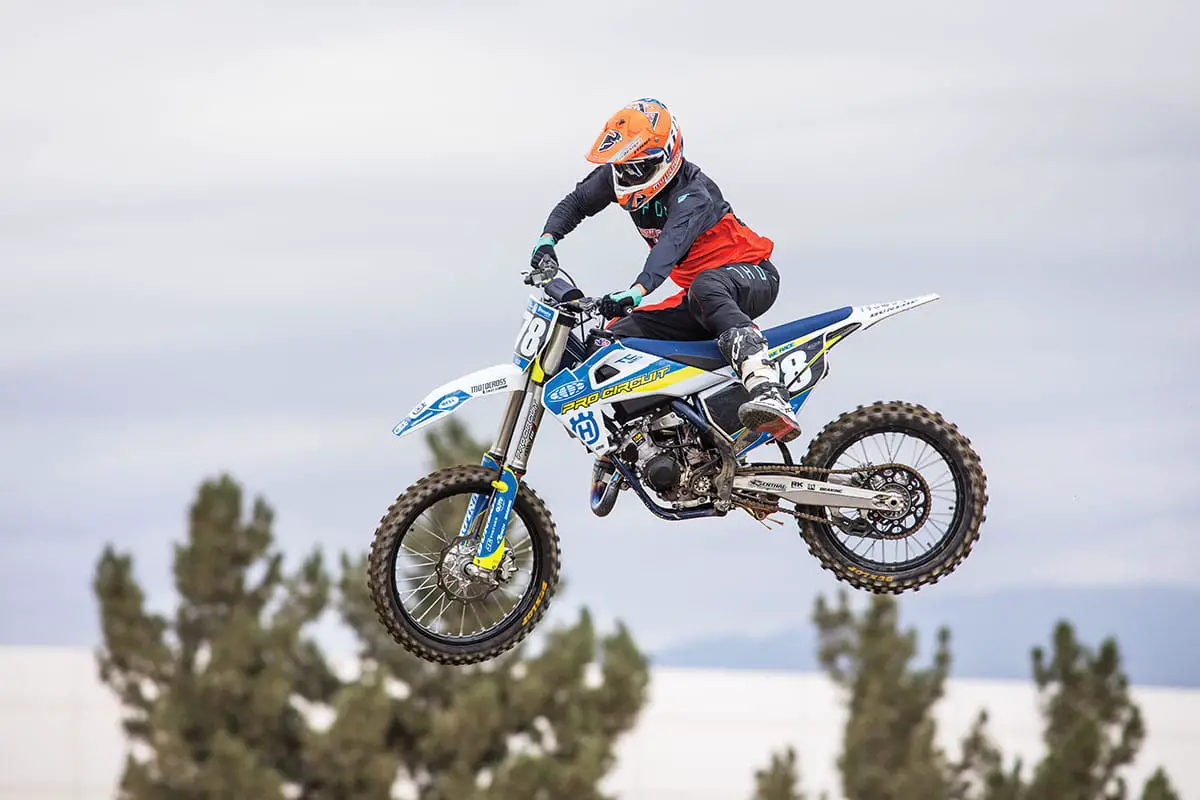 Ivan Tedesco turned Pro in 1999, which meant that he was on the front lines of the 125cc two-stroke wars for the first couple years of his career. But starting in 2002, the 125 class was inundated with 250 four-strokes. Although the Pro Circuit team resisted the transition to four-strokes at first, eventually Mitch gave his riders the choice of two or four. Ivan chose the KX250F four-stroke and won the 2005 AMA 125/250F National Championship at the final round over Mike Alessi—in the infamous incident where Alessi stood on Tedesco’s bike after they crashed together and tried to hit Ivan’s kill button. Over his 14-year AMA Pro career, Ivan won one National Championship, two 125 West Supercross titles, one 450 National, two 125 Nationals, and finished in the top 10 in 450 Supercross points five times and in the top 10 in National points four times. During his career, he raced for Plano Honda, Yamaha of Troy, Pro Circuit Kawasaki, Makita Suzuki, Red Bull Honda, Valli Yamaha, Hart & Huntington Kawasaki and spent his final year on KTMs.
Ivan Tedesco turned Pro in 1999, which meant that he was on the front lines of the 125cc two-stroke wars for the first couple years of his career. But starting in 2002, the 125 class was inundated with 250 four-strokes. Although the Pro Circuit team resisted the transition to four-strokes at first, eventually Mitch gave his riders the choice of two or four. Ivan chose the KX250F four-stroke and won the 2005 AMA 125/250F National Championship at the final round over Mike Alessi—in the infamous incident where Alessi stood on Tedesco’s bike after they crashed together and tried to hit Ivan’s kill button. Over his 14-year AMA Pro career, Ivan won one National Championship, two 125 West Supercross titles, one 450 National, two 125 Nationals, and finished in the top 10 in 450 Supercross points five times and in the top 10 in National points four times. During his career, he raced for Plano Honda, Yamaha of Troy, Pro Circuit Kawasaki, Makita Suzuki, Red Bull Honda, Valli Yamaha, Hart & Huntington Kawasaki and spent his final year on KTMs.
THE 2019 HUSQVARNA TC125 WAS MORE OF WHAT A HARDCORE 125
RACER WOULD WANT FROM A 2019 TIDDLER. IN A WAY, YOU HAVE TO
EXPECT THIS, BECAUSE THE HUSQVARNA ENGINE IS BRAND NEW
FOR 2019 AND THE YAMAHA YZ125 ENGINE WAS BRAND NEW IN 2005.
Since retiring, Ivan has been working as a test rider for various factory teams and currently does all of the test riding for the Pro Circuit/Monster Energy Kawasaki team. His connection to Pro Circuit is how the “Ivan Tedesco 2019 Husqvarna TC125” came to fruition. Since Husqvarna’s Andy Jefferson was a Pro Circuit rider back in the 1980s, he asked Mitch Payton if he would like to field Ivan Tedesco in the 125 Two-Stroke All-Star race at Washougal (the race Ryan Villopoto would win on a Pro Circuit YZ125) on a Husqvarna TC125. Mitch said yes, but at the time, 2019 TC125s were in short supply, so Andy asked MXA’s Jody Weisel if MXA would lend Mitch its Husqvarna TC125 test bike. MXA agreed to lend Pro Circuit its TC125 (and after the Washougal race, MXA would get to test Ivan Tedesco’s full-race Husky TC125). Mitch would get a bike to build for Ivan. Tedesco would get a bike to race, and Husqvarna would get lots of publicity. It was a great plan that should have benefited everyone involved.
It goes without saying that this is a true-to-life test of Ivan Tedesco’s 2019 Husqvarna TC125—the only problem? Ivan Tedesco never got to ride it. The bike didn’t get done in time to make it into the Pro Circuit Kawasaki semi when it left Corona, California, for Washougal, Washington. After missing the deadline, Mitch decided to take his time with the Husky TC125 project and get all new stampings made for a next-generation exhaust pipe. Ivan Tedesco’s TC125 was finished for the MXA wrecking crew—not Ivan Tedesco.
In retrospect, we think that Ivan would have had a really good shot at winning the 125 All-Star race at Washougal on the TC125 for two reasons. Ivan is good at Washougal, having won an AMA National there before, and his 2019 Husqvarna TC125 was an animal. As far as race prep goes, Mitch Payton did the exact same things to Tedesco’s TC125 engine that he did to Ryan Villopoto’s YZ125 engine (port, head, Moto Tassinari reed, Works pipe and R-304 silencer). The difference was that the Husqvarna TC125 engine responded to the mods much better. In fact, Ivan Tedesco’s engine pumped out 42.02 horsepower, which was 4 more horsepower than Ryan Villiopoto’s YZ125, plus torque was up a pound-foot on the Husky. Even more shocking was that the Tedesco engine generated 5.25 horsepower more than the stock 2019 Husqvarna TC125 powerplant (and it was 8 horsepower up on the stock engine by the time the TC125 signed off at 12,400 rpm).
Mitch admits that there were lots of things that he did to his AMA National and Supercross 125 two-strokes that could have made the YZ125 and TC125 both better, but since these 125s were made for one-off races and ridden by retired racers who didn’t have full-time mechanics, it was best to go with conventional two-stroke mods and a lot less razzle-dazzle.
The difference between racing Villopoto’s YZ125 and Tedesco’s TC125 was in the skill level required. Villopoto’s YZ125 was easy to ride; it’s powerband was broad and full. It didn’t make a lot of peak horsepower, but it never laid down out of a corner or required excessive clutching. It used all the power it had at the right time and in the right place. By comparison, the modded Pro Circuit TC125 engine was a rocket ship—it was a traditional, high-strung, go-for-broke, 125cc race engine. It hit hard at 9000 rpm and never stopped pulling. It made more horsepower than all but the most potent 250 four-stroke engines, and it demanded the rider’s constant attention. It was fast and, in the right hands, it was a winner. Oh heck, in the wrong hands, it was still fast enough to holeshot every race, pull the pack on long straights and make up for the occasional bobble coming out of corners.
Our jetting with the high-compression engine, Pro Circuit pipe, Moto Tassinari reed and MXR02 fuel was a 480 main, 30 pilot, 4.0 slide and 68FY42-71 needle.
The rest of the Husky package was first-rate—great brakes, awesome clutch, accurate handling and clean ergos. For Tedesco’s riding style, Pro Circuit re-valved his forks and shock, with the biggest change being a swap to Pro Circuit’s Air-To-Spring Conversion kit (which meant replacing the air side of the WP forks with an 8.0 N/m coil spring and 375cc of oil). The air-to-spring fork kit retails for $650. The spring is $65, and the re-valve is $165 (bringing the fork total to $880). The shock spring was upped from a 42 N/m to a 45, and a special $350.00 Pro Circuit linkage system (with bell crank and pull rods) was added to change the rising rate. We liked his fork mod. It worked well and didn’t require our frazzled race-day attention.
The 2019 Husqvarna TC125 was more of what a hardcore 125 racer would want than the YZ125. In a way, you have to expect this, because the Husqvarna engine is brand new for 2019 and the Yamaha YZ125 engine was brand new in 2005 (when Ivan Tedesco won the 125 National Championship).
WE RIDE DAMON BRADSHAW’S 2019 GAS GAS XC300
 Damon Bradshaw is the winningest rider to never win a major AMA National Championship. He did earn the 125 East Supercross title in 1987, but that is a Regional Championship, not a national title. Damon was no slouch and was always a threat to win. He won 19 AMA Supercrosses, six AMA 250 Nationals and four AMA 125 Nationals. Most amazing, Damon Bradshaw won nine Supercross events in 1992, only to lose the 1992 AMA Supercross Championship by three points to Jeff Stanton. Stanton won three events to Bradshaw’s nine, but Damon lost 23 points to Stanton at the Indianapolis round when he crashed. Damon was dropped from Team Yamaha at the end of 1996 and raced one final season as a privateer for Manchester Honda—winning his first 250 National in four years at Mt. Morris in 1997. At the end of the 1997 season, he retired from Pro racing and moved over to race Monster trucks from 2007 until 2017, driving the “Air Force Afterburner” in Monster Jam.
Damon Bradshaw is the winningest rider to never win a major AMA National Championship. He did earn the 125 East Supercross title in 1987, but that is a Regional Championship, not a national title. Damon was no slouch and was always a threat to win. He won 19 AMA Supercrosses, six AMA 250 Nationals and four AMA 125 Nationals. Most amazing, Damon Bradshaw won nine Supercross events in 1992, only to lose the 1992 AMA Supercross Championship by three points to Jeff Stanton. Stanton won three events to Bradshaw’s nine, but Damon lost 23 points to Stanton at the Indianapolis round when he crashed. Damon was dropped from Team Yamaha at the end of 1996 and raced one final season as a privateer for Manchester Honda—winning his first 250 National in four years at Mt. Morris in 1997. At the end of the 1997 season, he retired from Pro racing and moved over to race Monster trucks from 2007 until 2017, driving the “Air Force Afterburner” in Monster Jam.
BRADSHAW’S RACE BIKE GETS ITS BONES FROM A PURPOSE-BUILT
CROSS-COUNTRY MODEL. THAT MAKES THE JOB OF TURNING
IT INTO A MOTOCROSS BIKE MUCH MORE COMPLICATED.
In keeping with the brand ambassador trend for retired racers, in 2017 Damon became the brand ambassador for Western Power Sports (WPS) and the Spanish GasGas motorcycle brand, which is where MXA came into the picture. Although GasGas specializes in enduro, GNCC and trials bikes, the company has always wanted to build a motocross version of its XC300 offroad two-stroke. The hiring of Damon Bradshaw gave them the opportunity to build a special one-off version with all the bells and whistles for Damon to race.
Unlike his fellow senior citizens’ bikes (Ryan, Ivan and Travis), Damon’s race bike gets its bones from a purpose-built cross-country model. That makes the job of turning it into a motocross bike much more complicated. First, the GasGas needed to lose some weight. Since the XC300 is more of a cross-country bike than its EC300 enduro cousin, much of the work was done at the GasGas factory for the 2018 production model. The biggest change for Bradshaw’s purposes was the removal of the electric starter motor and battery. This saved 6 pounds. In stock trim, the GasGas XC300 already comes with an FMF exhaust, Moto Tassinari VForce reed and Keihin carb. Back in 2018, the Spanish machines got KYB suspension front and rear (replacing the less-than-stellar Sachs shock and Marzocchi forks).
The biggest problem for the XC300 engine is that it was designed with a cylinder that delivers a torquey, low-to-mid style of power. GasGas enlisted the help of R&D’s Dean Dickenson to bring the cylinder to life, but Dean felt that the port timing was as high as it could be. He focused his attention on the position of the power valve flapper in the exhaust port because it limited the cylinder’s ability to make serious motocross power. The real problem was that the pivot point of the power valve did not allow it to completely clear the exhaust port when open. He worked on the power valve but felt that this cylinder had reached its limitations.
Given that the GasGas XC300 displaces 299.3cc, it isn’t short on power, just revability. With the cranks balanced, a six-speed gearbox, an FMF Factory Fatty pipe and Powercore 2.1 silencer, the real goal was to maximize what the GasGas XC300 was good at and not worry too much about what couldn’t be fixed.
As for Damon Bradshaw’s one-off motocross version, it features SR1 Suspension from Taylorsville, North Carolina. The stock Magura hydraulic clutch connects to a Rekluse clutch to ensure positive engagement at all times. A Magura hydraulic master cylinder operates Nissin brake calipers against Barcelona-made NG rotors. The footpegs are titanium Pro Pegs from Works Connection. The hubs are by Haan, laced to Excel A60 rims by KSR wheels (with a 51-tooth Renthal rear sprocket). The handlebars are Renthal 996 TwinWalls mounted in Xtrig PHDS bar mounts. Damon Bradshaw, like Villopoto and Tedesco before him, went with ARC levers. The radiators had welded tanks for durability, and the tires were Shinko enduro tires—a 216MX on the front and an ST525 on the rear.
Okay, we admit that we were very surprised by Damon Bradshaw’s GasGas XC300 project. Surprised in a good way. It was comfortable and well balanced fore and aft. The suspension was plush in an offroad manner but usable on a motocross track without issue. It was on the heavy side for a motocross bike, even with the electric starter, kickstand and miscellaneous offroad foof removed. It has the potential to be a really good motocross bike, but the engine is pure offroad. Damon’s GasGas power was so focused on the low-to-mid transition that there was no mid-to-high power to speak of. No surprise. This is fairly common with 72mm x 72mm bore and stroke 300cc engines, which are basically 250cc engines with a 5.6mm larger bore. The big piston has to push a lot of swept area, which restricts its ability to turn revs. And the high-compression ratio and 110-octane Torco race gas couldn’t push it through.
Once we learned to work with the powerband, take advantage of the 300cc engine’s torque, lug it through the corners and shift at peak, we really enjoyed the GasGas chassis, which is much more forgiving than the overbuilt chromoly perimeter frames that they used to build. Living with the GasGas was fun. We’d like it a lot better with a modern engine design that was willing to deliver a more all-encompassing powerband. Good try, but the goodness was overshadowed by the oldness.
WE RIDE TRAVIS PASTRANA’S 2005 FACTORY SUZUKI RM250
Travis Pastrana won the 2000 AMA 125 National Championship and 2001 AMA 125 East Supercross title, but in 2005 he made the decision to focus on his daredevil interests and put motocross on the back burner. Since then, Travis has accomplished more than a small army could. He’s done rally cars, the X Games, NASCAR, sky diving, Supermoto, Nitro Circus and, most recently, he duplicated Evel Knievel’s Las Vegas jumps. But, no one thought he would come out of retirement for the biggest motocross event in the world—the Motocross des Nations.
WE ALL THOUGHT THAT IT WOULD BE WEIRD TO RIDE TRAVIS’ SETUP, AS IT WAS SO DIFFERENT FROM STOCK WITH THE TALL SEAT AND LOW PEGS, BUT THAT WASN’T THE CASE.
With the 2018 MXDN being in the United States, the wheels in Travis’ head started spinning at a dangerously high rpm. Travis’ dad, Robert Pastrana, is of Puerto Rican decent, making Travis eligible to represent Puerto Rico in FIM international competition. Funny thing, Travis already had a Pro license that he originally got back in 2008 from the Puerto Rican Motorcycle Association to represent the territory. Who knew that it would come in handy a decade later.
After Hurricane Maria devastated Puerto Rico in 2017, with an estimated $91 billion in damages, Travis wanted to help raise money by putting together a Puerto Rican Motocross des Nations team. They would race and solicit donations to help the island territory. First, Travis wanted it to be a full two-stroke team with Jimmy Albertson (in his Ronnie Mac guise), Ryan Sipes and himself. The Ronnie Mac persona brought too much negative attention to the team, so Kevin Windham was asked to step in. In spite of being retired and on the couch for five years, Kevin accepted Travis’ challenge to race. Windham was the end of Travis’ two-stroke dream, though, because Kevin was a four-stroke guy through and through.
Travis knew that he would be faster on a 450, but he let the world decide by posting the options on his social media. Whatever the consensus, he would oblige. The world wanted nothing but smoke, which was what Travis wanted anyway. Although his first choice was his RM-Zilla—the 500cc engine shoehorned into an RM-Z chassis that he raced at the 2014 Red Bull Straight Rhythm—the FIM didn’t like that idea, as it was against the rules to have 500cc of displacement. Travis went with Plan B.
Travis had always wanted to be the first to do a triple backflip and had been piecing together the perfect bike for the trick. Suzuki came through with an old factory 2005 RM250 engine with a factory Keihin carburetor and CDI box that was rumored to be one of Ricky Carmichael’s engines. Travis never perfected the triple backflip and eventually passed the torch to his friend Josh Sheehan, who was able to pull-off the death-defying feat in 2015.
But, Travis still had the 2005 RM250 works engine, so when Travis had to switch to Plan B for the 2018 MXDN, he put the engine into a box-stock 2005 RM250 chassis. Travis’ old Suzuki factory mechanic, James Coy, was in charge of acquiring the parts needed to finish the bike in time. James and Travis started digging in the attic for boxes of old factory RM250 titanium for the bike. Could you let go of factory titanium bolts that would never be made again? Neither could Travis. It took time, but James was able to scrape up a full set of titanium bolts for the bike.
They could have found some old factory suspension, but there was better technology on the market that would match up well with the old RM250. Showa built up a set a JGR RM-Z450 factory suspension for Travis. Out with the old and in with the new.
Just two weeks before the MXDN, Travis was rolling out his legs when a piece of scar tissue from an old injury snapped, swelling up his knee to the point where he couldn’t get his foot on the peg when he sat down. James found the tallest seat foam he could and moved the titanium Pro Peg footpegs down and back 10mm. The day before the race, he still couldn’t put his foot on the peg. The thing with Travis is that if he says he is going to do something, he does it—sleep deprived, injured or not. That is his character. The entire 24 hours before the Red Bud MXDN, he iced his leg. On the morning of the race, he was barely able to get his foot on the peg, but he got it there.
The MXA wrecking crew had set up a test of Travis’ bike for a week after the Motocross des Nations, but it almost didn’t happen. During the MXDN, Travis broke the factory engine in the first moto, so we thought our test was over. But after Red Bud, Travis’ RM250 was shipped back to California, where Suzuki graciously supplied the works engine parts to rebuild Travis’ engine so that MXA’s test could go on.
We all thought that it would be weird to ride Travis’ setup, as it was so different from stock with the tall seat and low pegs, but it wasn’t the case. Our test riders were 5-foot-9 to 5-foot-11, and they were tippy-toed when sitting on Travis’ RM250. It felt tall—really tall. As our test riders rolled onto the track, the tall sensation disappeared—until they came to a stop again. In stock trim, the old 2005 RM250 had a big dip in the seat. That was the style a decade ago. Travis’ ergonomics felt more modern, as the trend lately has been taller and flatter cockpits. The factory-tuned Showa components were balanced, as our testers were right around Travis’ 185-pound weight. The suspension tracked the ground especially well and absorbed anything that came its way.
The factory engine sang the perfect tune as the throttle cracked open. The bottom-to-mid power was potent but got it to the ground—unlike the modern KTM 250SX. The momentum built up, and the power allowed the rider to ride third and short shift if he wanted, but he didn’t have to, as it pulled well on top. Every test rider said the 2005 works engine was better than any modern production two-stroke by leaps and bounds. The factory transmission had perfect shift points from gear to gear, and the carb, ECU and engine worked in unison.
The bike was perfect, save for one peculiar setup feature that Travis used. The front brake was so touchy that it almost threw us over the bars with a gentle tap of the lever. It was a light switch, and riders found it hard to cope with.
We miss the glory days of factory two-strokes, and so do the riders. Travis has tried to keep two-strokes alive, even though Suzuki hasn’t made a RM250 smoker since 2008. If Suzuki doesn’t make two-strokes again, sales of used RM250s will be very brisk.



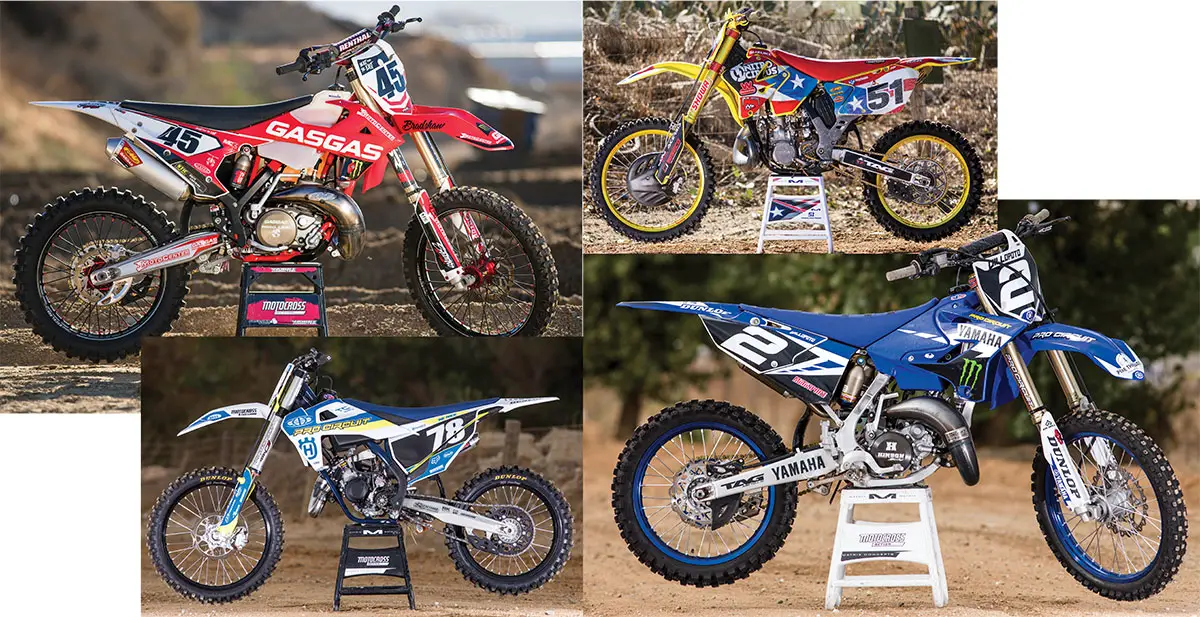
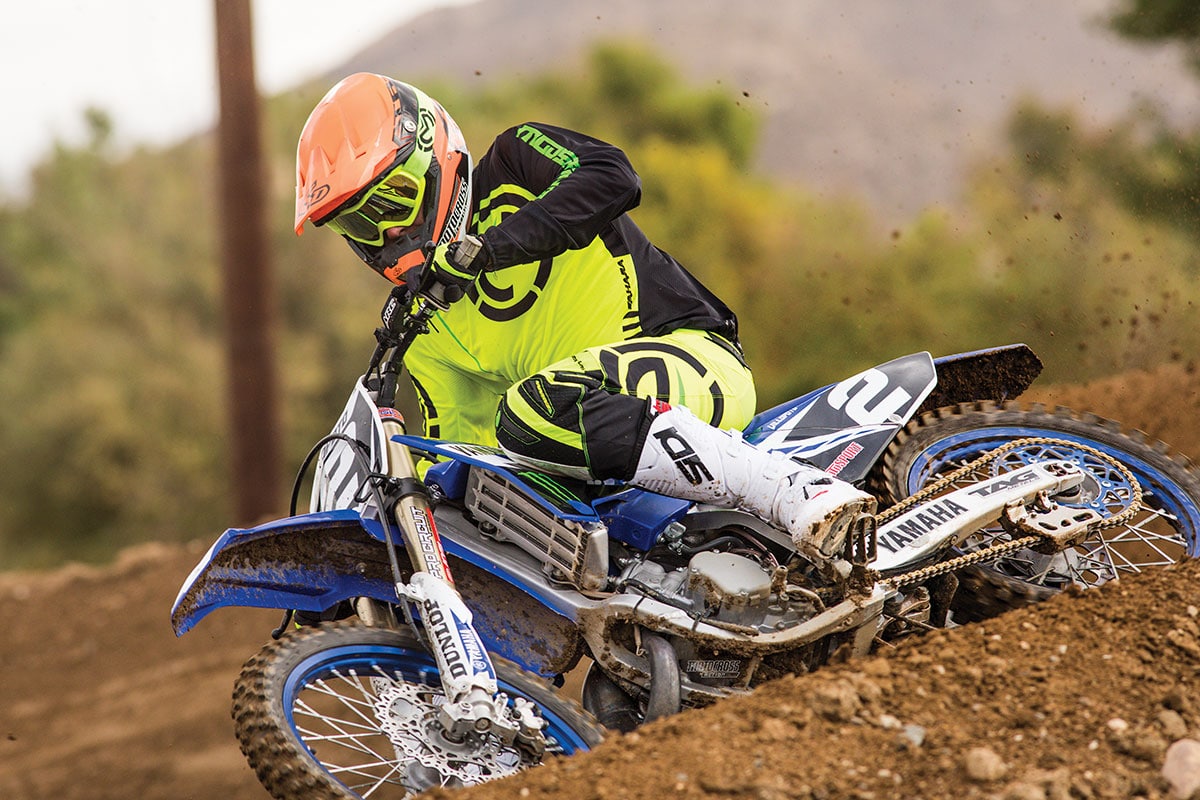




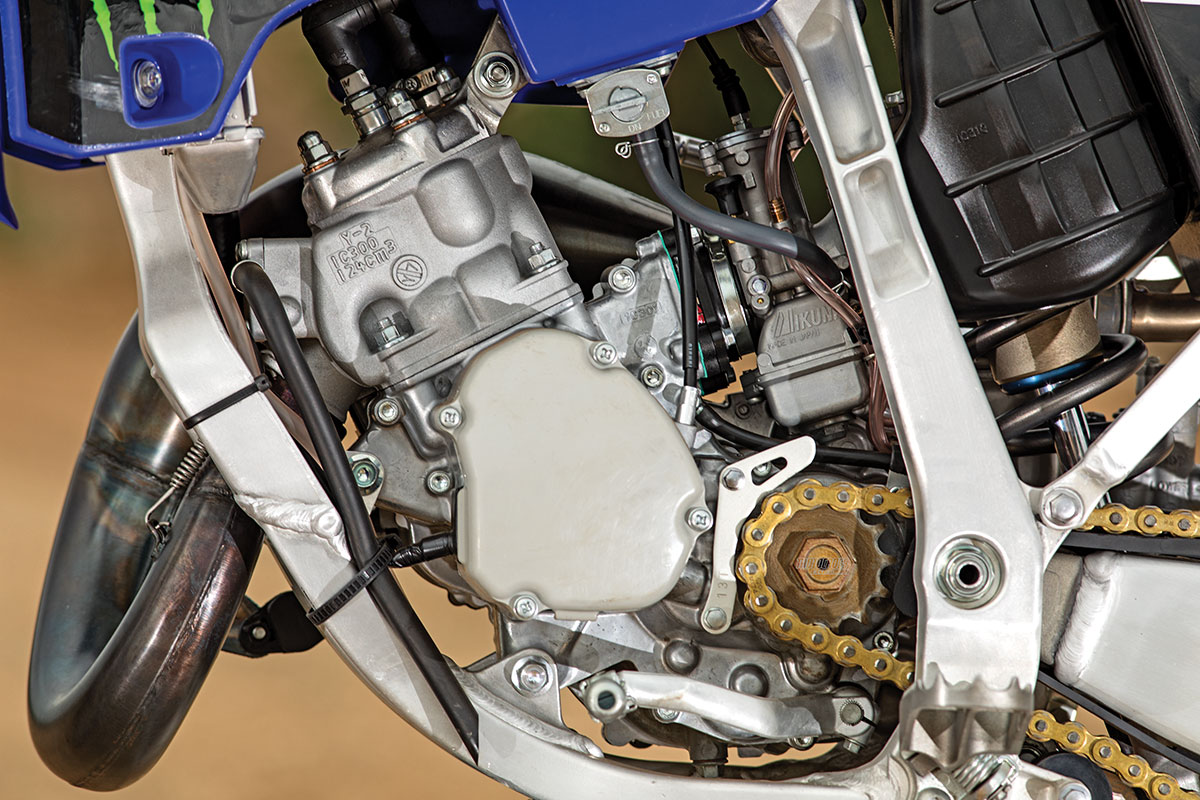



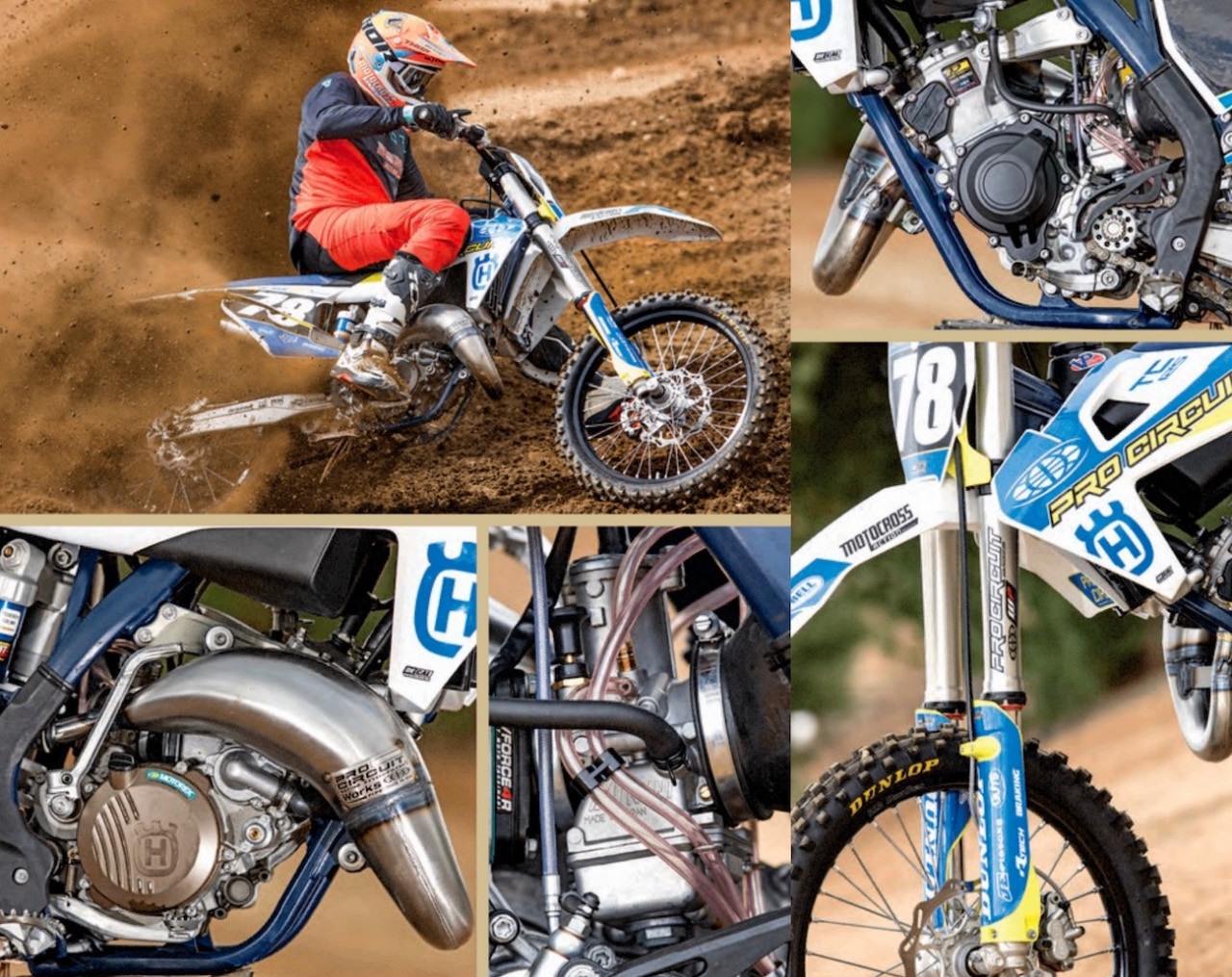








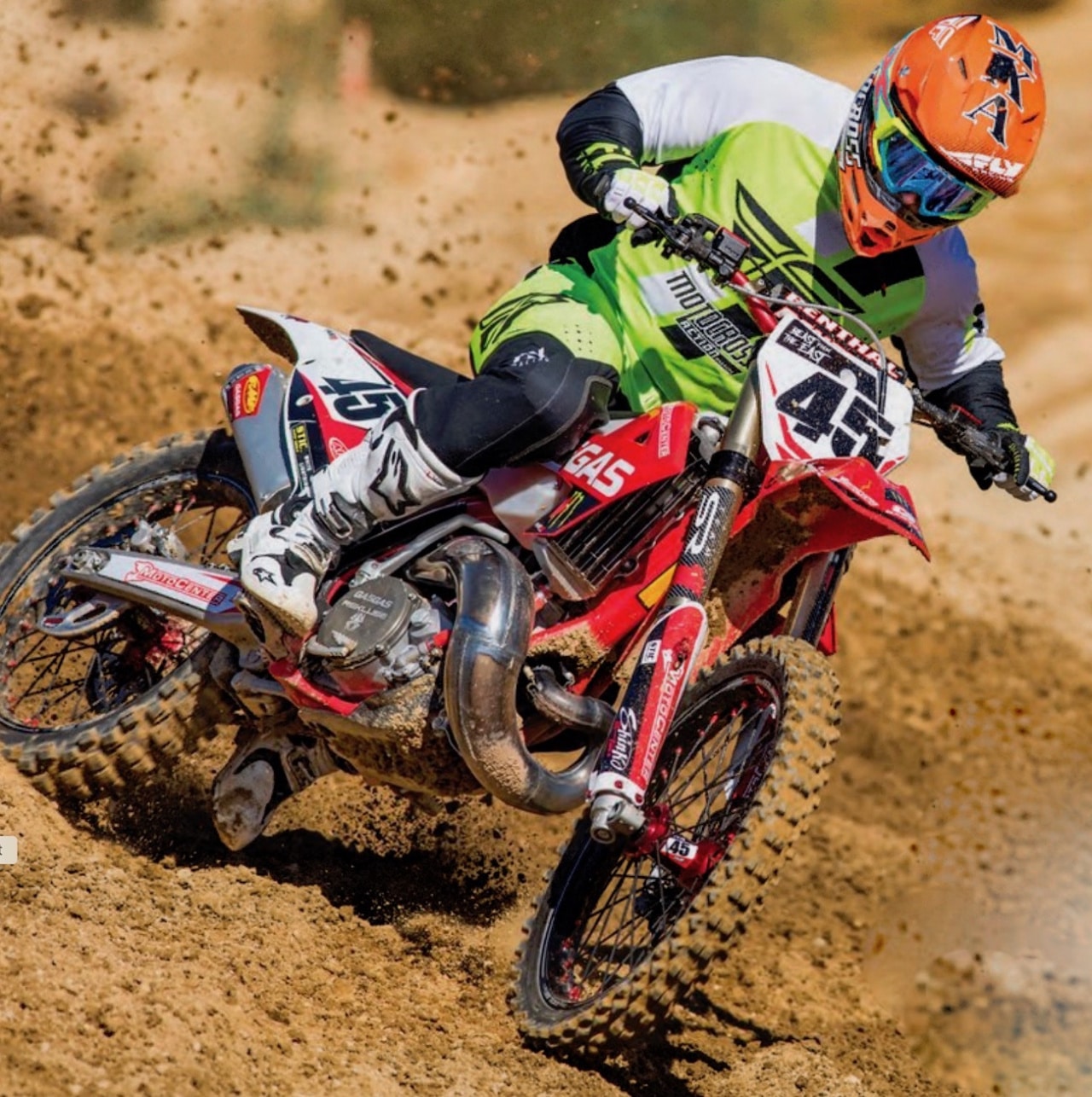


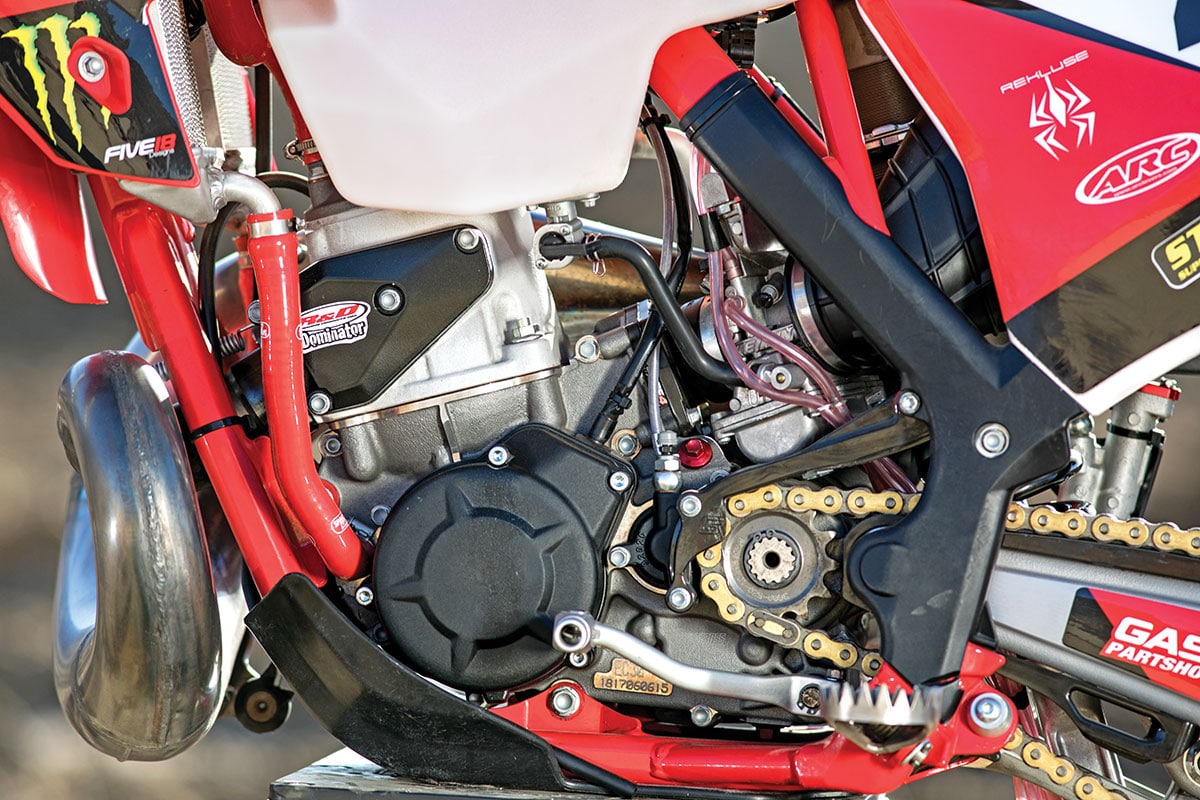




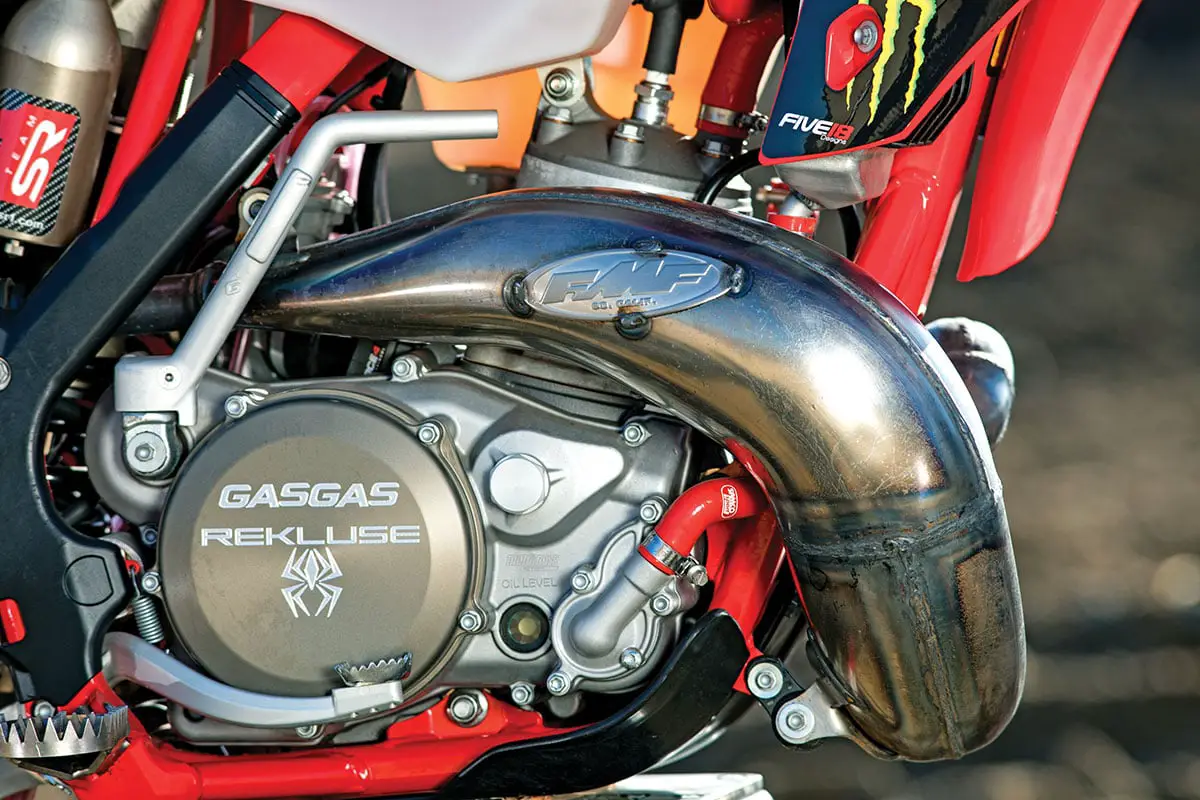
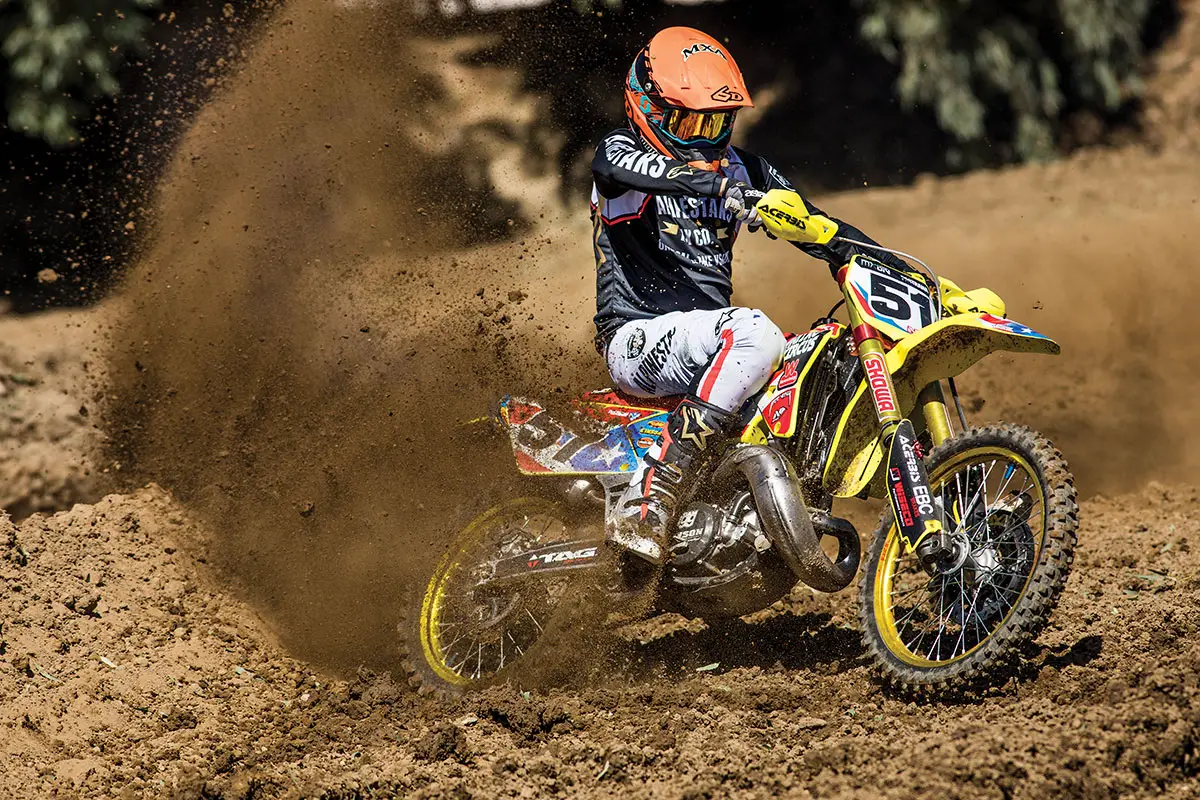


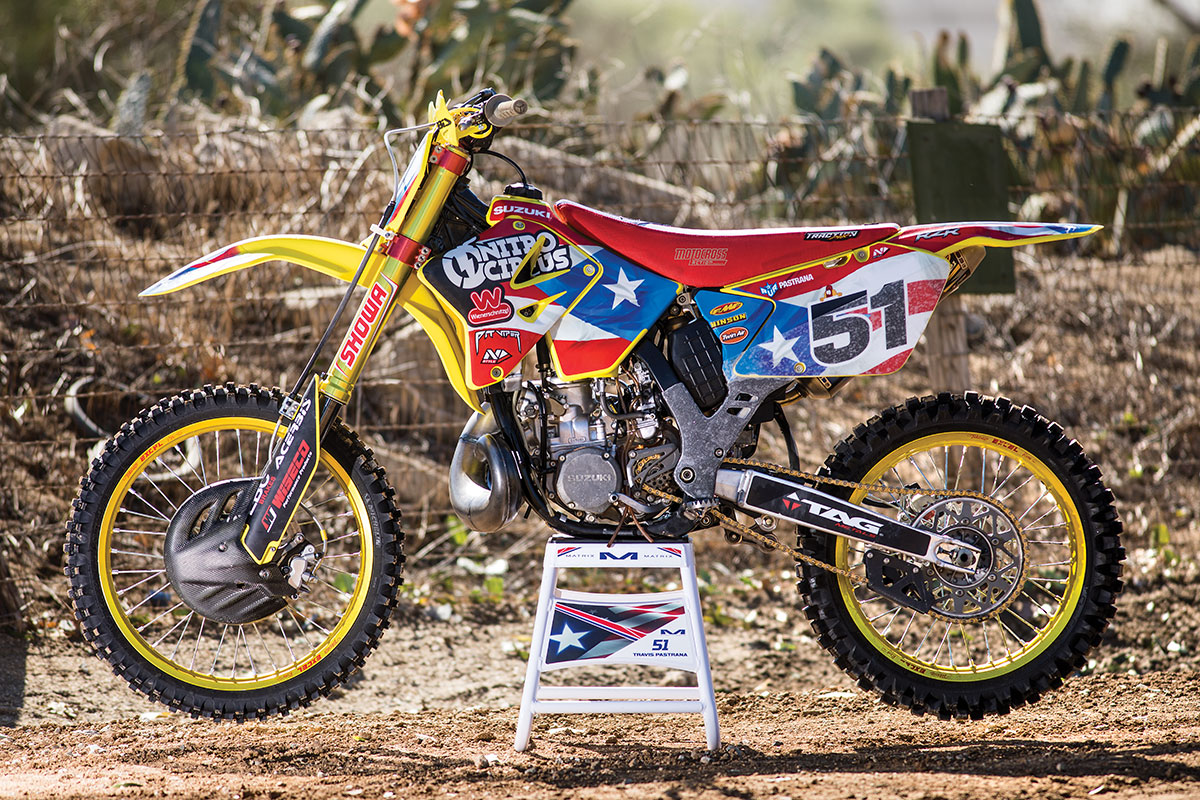

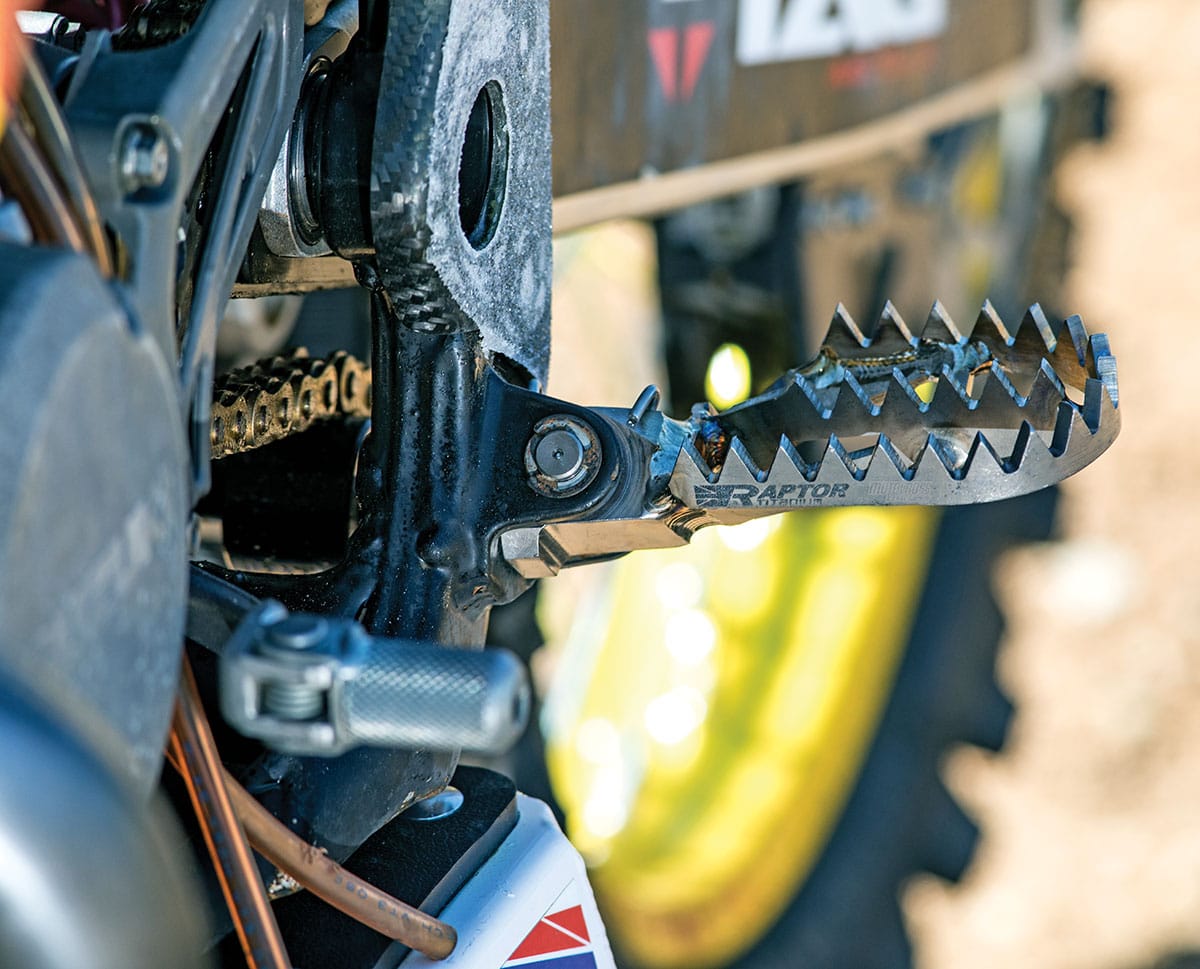





Comments are closed.